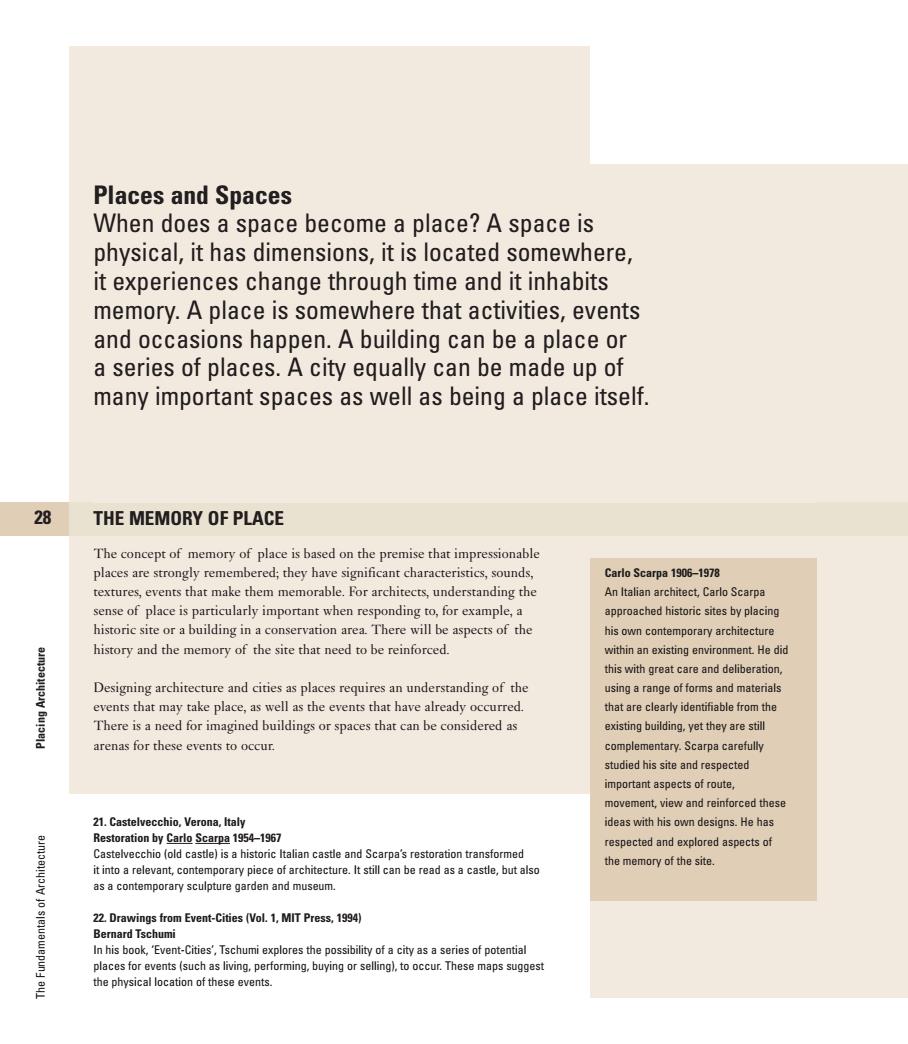
Places and Spaces When does a space become a place?A space is physical,it has dimensions,it is located somewhere, it experiences change through time and it inhabits memory.A place is somewhere that activities,events and occasions happen.A building can be a place or a series of places.A city equally can be made up of many important spaces as well as being a place itself. 28 THE MEMORY OF PLACE The concept of memory of place is based on the premise that impressionable places are strongly remembered;they have significant characteristics,sounds, Carlo Scarpa 1906-1978 textures,events that make them memorable.For architects,understanding the An Italian architect,Carlo Scarpa sense of place is particularly important when responding to,for example,a approached historic sites by placing historic site or a building in a conservation area.There will be aspects of the his own contemporary architecture history and the memory of the site that need to be reinforced. within an existing environment.He did this with great care and deliberation, Designing architecture and cities as places requires an understanding of the using a range of forms and materials events that may take place,as well as the events that have already occurred. that are clearly identifiable from the There is a need for imagined buildings or spaces that can be considered as existing building,yet they are still arenas for these events to occur. complementary.Scarpa carefully studied his site and respected important aspects of route, movement,view and reinforced these 21.Castelvecchio,Verona,Italy ideas with his own designs.He has Restoration by Carlo Scarpa 1954-1967 respected and explored aspects of Castelvecchio (old castle)is a historic Italian castle and Scarpa's restoration transformed it into a relevant,contemporary piece of architecture.It still can be read as a castle,but also the memory of the site. as a contemporary sculpture garden and museum. 22.Drawings from Event-Cities (Vol.1,MIT Press,1994) Bernard Tschumi uawepun In his book,'Event-Cities',Tschumi explores the possibility of a city as a series of potential places for events(such as living,performing,buying or selling),to occur.These maps suggest 黑 the physical location of these events
QC Preflight Point 1st 11 11 p28 Job no : 76451 Title : The Fundamentals of Architecture Client : AVA Scn : #175 Size : 200(w)230(h)mm Co : M11 C0 (All To Spot)(Coagl)__LC Dept : DTP D/O : 07.05.07 (Job no:000000 D/O : 00.00.07 Co: CM0) 74561_CTP_001-051.qxd 5/3/07 11:02 AM Page 28 1st p28 28Placing Architecture The Fundamentals of Architecture Places and Spaces When does a space become a place? A space is physical, it has dimensions, it is located somewhere, it experiences change through time and it inhabits memory. A place is somewhere that activities, events and occasions happen. A building can be a place or a series of places. A city equally can be made up of many important spaces as well as being a place itself. THE MEMORY OF PLACE The concept of memory of place is based on the premise that impressionable places are strongly remembered; they have significant characteristics, sounds, textures, events that make them memorable. For architects, understanding the sense of place is particularly important when responding to, for example, a historic site or a building in a conservation area. There will be aspects of the history and the memory of the site that need to be reinforced. Designing architecture and cities as places requires an understanding of the events that may take place, as well as the events that have already occurred. There is a need for imagined buildings or spaces that can be considered as arenas for these events to occur. 21. Castelvecchio, Verona, Italy Restoration by Carlo Scarpa 1954–1967 Castelvecchio (old castle) is a historic Italian castle and Scarpa’s restoration transformed it into a relevant, contemporary piece of architecture. It still can be read as a castle, but also as a contemporary sculpture garden and museum. 22. Drawings from Event-Cities (Vol. 1, MIT Press, 1994) Bernard Tschumi In his book, ‘Event-Cities’, Tschumi explores the possibility of a city as a series of potential places for events (such as living, performing, buying or selling), to occur. These maps suggest the physical location of these events. Carlo Scarpa 1906–1978 An Italian architect, Carlo Scarpa approached historic sites by placing his own contemporary architecture within an existing environment. He did this with great care and deliberation, using a range of forms and materials that are clearly identifiable from the existing building, yet they are still complementary. Scarpa carefully studied his site and respected important aspects of route, movement, view and reinforced these ideas with his own designs. He has respected and explored aspects of the memory of the site. 74561_CTP_001-051.qxd 5/3/07 11:02 AM Page 28
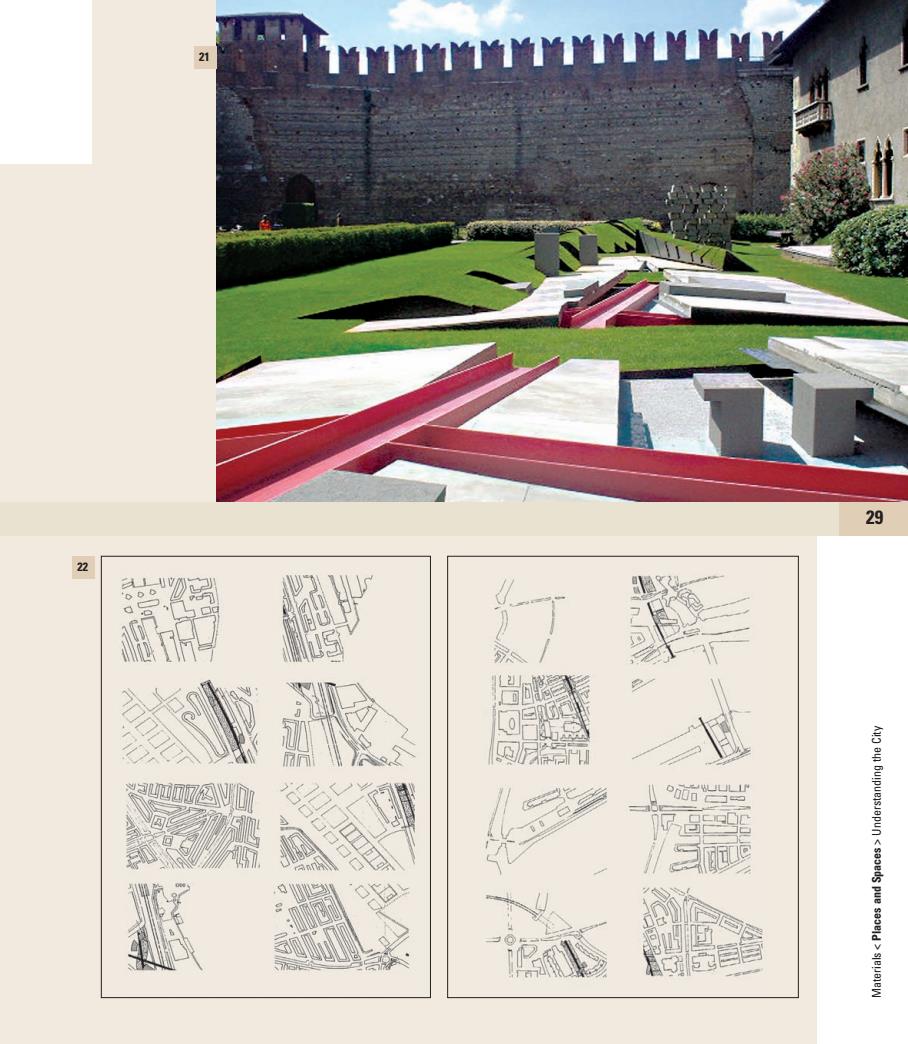
21 MMMMM 29 22 0 三或
p29 QC Preflight Point 2nd 11 11 Job no : 76451 Title : The Fundamentals of Architecture Client : AVA Scn : #175 Size : 200(w)230(h)mm Co : M11 C0 (All To Spot)(Coagl)__LC Dept : DTP D/O : 07.05.07 (Job no: 76451C1 D/O : 25.05.07 Co: CM3) 76451_CTP_001-051.qxd 5/23/07 6:18 AM Page 29 p29 2nd 29Materials < Places and Spaces > Understanding the City 21 22 76451_CTP_001-051.qxd 5/23/07 6:18 AM Page 29
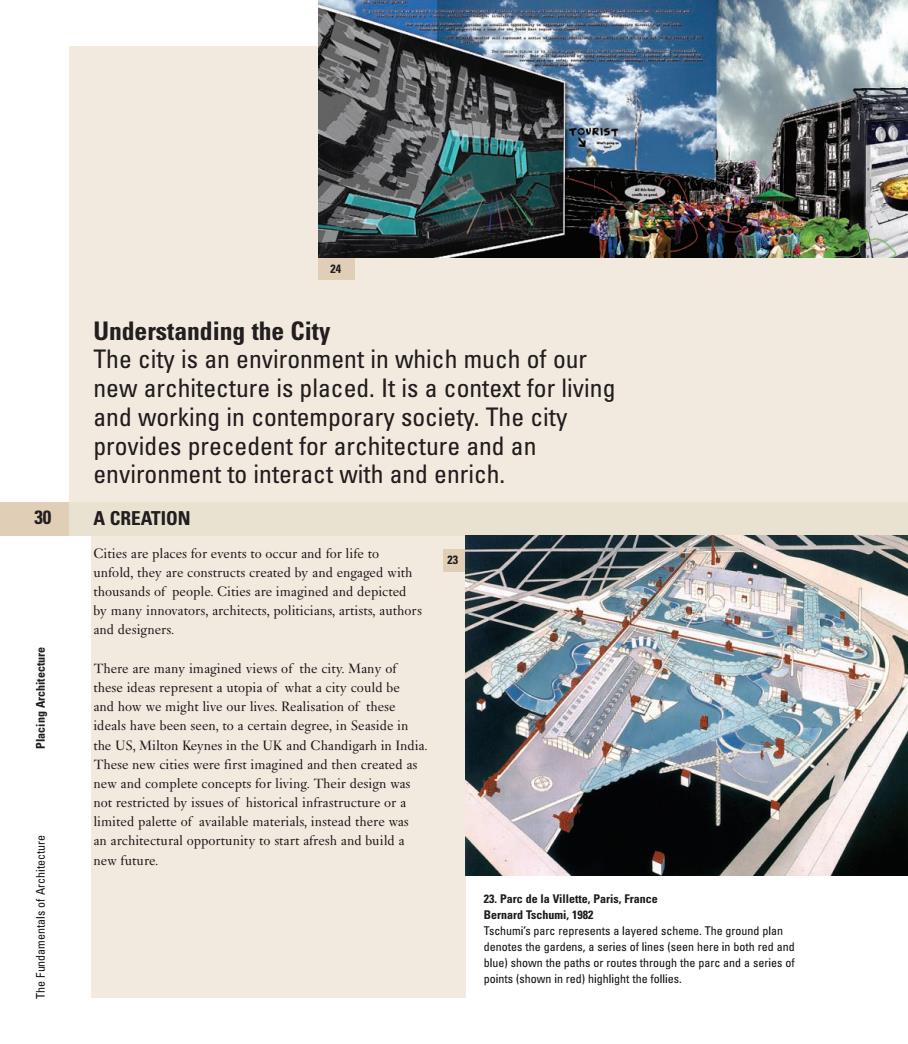
24 Understanding the City The city is an environment in which much of our new architecture is placed.It is a context for living and working in contemporary society.The city provides precedent for architecture and an environment to interact with and enrich. 30 A CREATION Cities are places for events to occur and for life to 23 unfold,they are constructs created by and engaged with thousands of people.Cities are imagined and depicted by many innovators,architects,politicians,artists,authors and designers. There are many imagined views of the city.Many of these ideas represent a utopia of what a city could be and how we might live our lives.Realisation of these ideals have been seen,to a certain degree,in Seaside in the US,Milton Keynes in the UK and Chandigarh in India These new cities were first imagined and then created as new and complete concepts for living.Their design was not restricted by issues of historical infrastructure or a limited palette of available materials,instead there was an architectural opportunity to start afresh and build a new future. 23.Parc de la Villette,Paris,France Bernard Tschumi,1982 Tschumi's parc represents a layered scheme.The ground plan denotes the gardens,a series of lines(seen here in both red and blue)shown the paths or routes through the parc and a series of points (shown in red)highlight the follies
p30 Job no : 76451 Title : The Fundamentals of Architecture Client : AVA Scn : #175 Size : 200(w)230(h)mm Co : M11 C0 (All To Spot)(Coagl)__LC Dept : DTP D/O : 07.05.07 (Job no:76451C1 D/O : 25.05.07 Co: CM11) QC Preflight Point 2nd 11 11 76451_CTP_001-051.qxd 5/25/07 9:08 AM Page 30 p30 (Job no:76451C1 D/O : 25.05.07 Co: CM11) 30Placing Architecture The Fundamentals of Architecture A CREATION Cities are places for events to occur and for life to unfold, they are constructs created by and engaged with thousands of people. Cities are imagined and depicted by many innovators, architects, politicians, artists, authors and designers. There are many imagined views of the city. Many of these ideas represent a utopia of what a city could be and how we might live our lives. Realisation of these ideals have been seen, to a certain degree, in Seaside in the US, Milton Keynes in the UK and Chandigarh in India. These new cities were first imagined and then created as new and complete concepts for living. Their design was not restricted by issues of historical infrastructure or a limited palette of available materials, instead there was an architectural opportunity to start afresh and build a new future. 23 Understanding the City The city is an environment in which much of our new architecture is placed. It is a context for living and working in contemporary society. The city provides precedent for architecture and an environment to interact with and enrich. 23. Parc de la Villette, Paris, France Bernard Tschumi, 1982 Tschumi’s parc represents a layered scheme. The ground plan denotes the gardens, a series of lines (seen here in both red and blue) shown the paths or routes through the parc and a series of points (shown in red) highlight the follies. 2nd 24 76451_CTP_001-051.qxd 5/25/07 9:08 AM Page 30
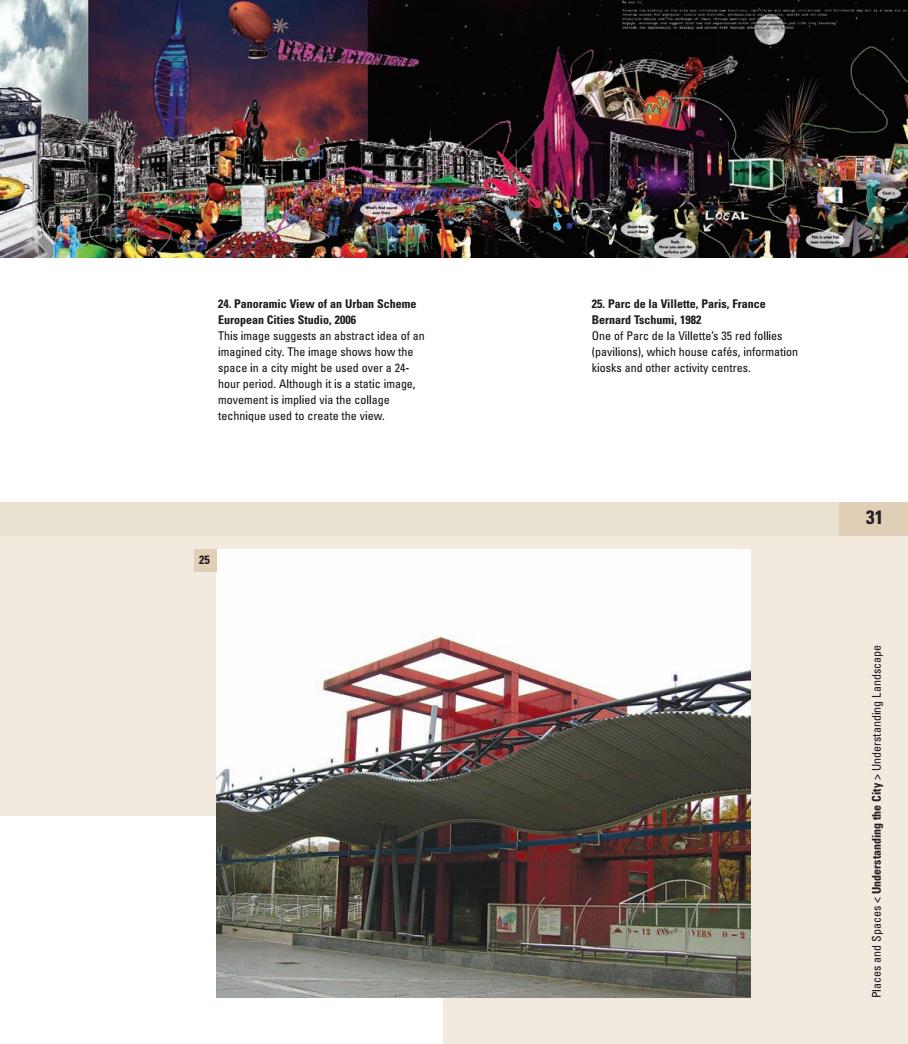
米 BAN ACTRTOR9 AL 24.Panoramic View of an Urban Scheme 25.Parc de la Villette,Paris,France European Cities Studio,2006 Bernard Tschumi,1982 This image suggests an abstract idea of an One of Parc de la Villette's 35 red follies imagined city.The image shows how the (pavilions),which house cafes,information space in a city might be used over a 24- kiosks and other activity centres hour period.Although it is a static image movement is implied via the collage technique used to create the view. 31 25 -1
QC Preflight Point 2nd 11 11 p31 76451_CTP_001-051.qxd 5/23/07 8:38 AM Page 31 2nd 31 24. Panoramic View of an Urban Scheme European Cities Studio, 2006 This image suggests an abstract idea of an imagined city. The image shows how the space in a city might be used over a 24- hour period. Although it is a static image, movement is implied via the collage technique used to create the view. 25. Parc de la Villette, Paris, France Bernard Tschumi, 1982 One of Parc de la Villette’s 35 red follies (pavilions), which house cafés, information kiosks and other activity centres. 25 Places and Spaces < Understanding the City > Understanding Landscape p31 76451_CTP_001-051.qxd 5/23/07 8:38 AM Page 31
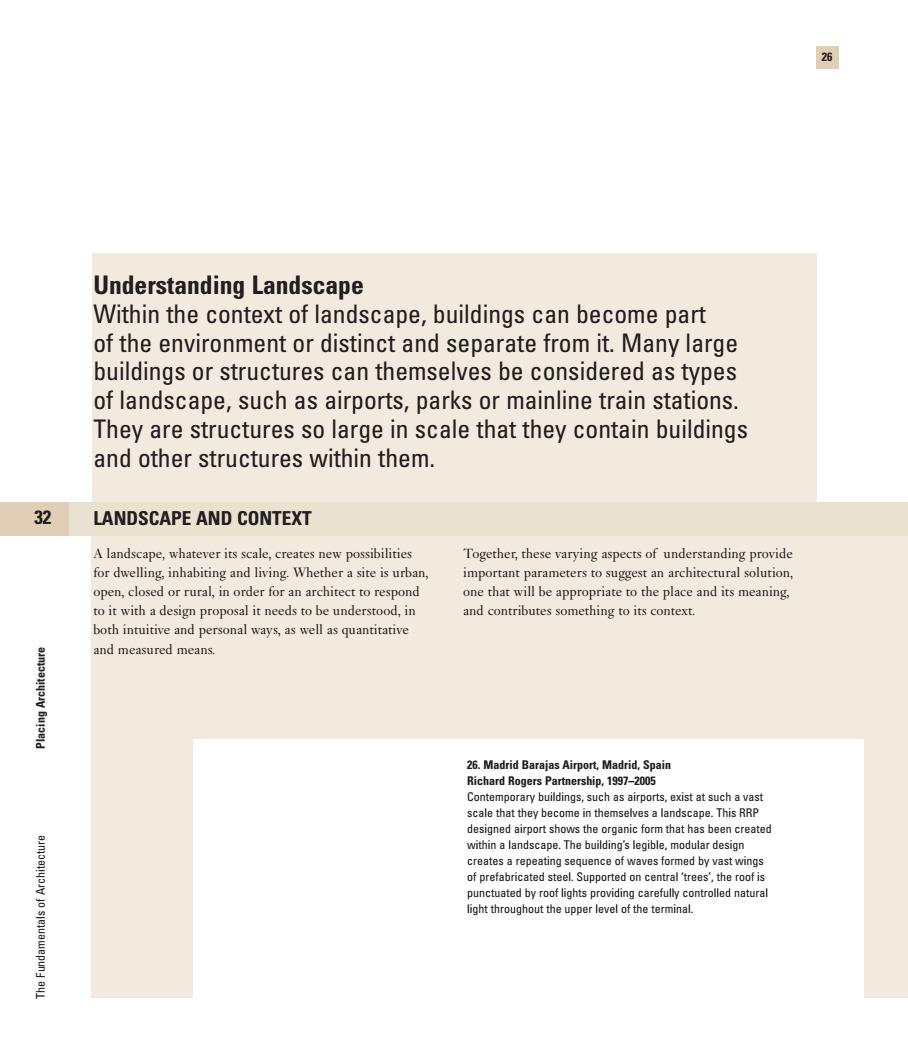
26 Understanding Landscape Within the context of landscape,buildings can become part of the environment or distinct and separate from it.Many large buildings or structures can themselves be considered as types of landscape,such as airports,parks or mainline train stations. They are structures so large in scale that they contain buildings and other structures within them. 32 LANDSCAPE AND CONTEXT A landscape,whatever its scale,creates new possibilities Together,these varying aspects of understanding provide for dwelling,inhabiting and living.Whether a site is urban, important parameters to suggest an architectural solution, open,closed or rural,in order for an architect to respond one that will be appropriate to the place and its meaning, to it with a design proposal it needs to be understood,in and contributes something to its context. both intuitive and personal ways,as well as quantitative and measured means. 26.Madrid Barajas Airport,Madrid,Spain Richard Rogers Partnership,1997-2005 Contemporary buildings,such as airports,exist at such a vast scale that they become in themselves a landscape.This RRP designed airport shows the organic form that has been created within a landscape.The building's legible,modular design creates a repeating sequence of waves formed by vast wings of prefabricated steel.Supported on central'trees',the roof is punctuated by roof lights providing carefully controlled natural light throughout the upper level of the terminal
QC Preflight Point 2nd 11 11 p32 Job no : 76451 Title : The Fundamentals of Architecture Client : AVA Scn : #175 Size : 200(w)230(h)mm Co : M11 C0 (All To Spot)(Coagl)__LC Dept : DTP D/O : 07.05.07 (Job no:76451c7 D/O : 14.09.07 Co: CM11) 76451_CTP_001-051.qxd 9/17/07 12:00 PM Page 32 2nd p32 (Job no:76451c7 D/O : 14.09.07 Co: CM11) Placing Architecture The Fundamentals of Architecture Understanding Landscape Within the context of landscape, buildings can become part of the environment or distinct and separate from it. Many large buildings or structures can themselves be considered as types of landscape, such as airports, parks or mainline train stations. They are structures so large in scale that they contain buildings and other structures within them. 26. Madrid Barajas Airport, Madrid, Spain Richard Rogers Partnership, 1997–2005 Contemporary buildings, such as airports, exist at such a vast scale that they become in themselves a landscape. This RRP designed airport shows the organic form that has been created within a landscape. The building’s legible, modular design creates a repeating sequence of waves formed by vast wings of prefabricated steel. Supported on central ‘trees’, the roof is punctuated by roof lights providing carefully controlled natural light throughout the upper level of the terminal. 26 LANDSCAPE AND CONTEXT A landscape, whatever its scale, creates new possibilities for dwelling, inhabiting and living. Whether a site is urban, open, closed or rural, in order for an architect to respond to it with a design proposal it needs to be understood, in both intuitive and personal ways, as well as quantitative and measured means. Together, these varying aspects of understanding provide important parameters to suggest an architectural solution, one that will be appropriate to the place and its meaning, and contributes something to its context. 32 76451_CTP_001-051.qxd 9/17/07 12:00 PM Page 32